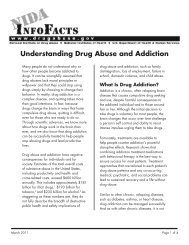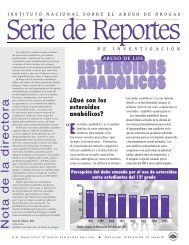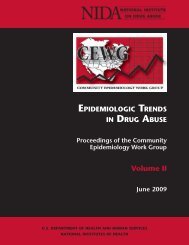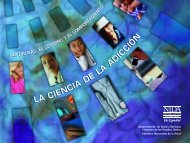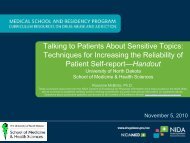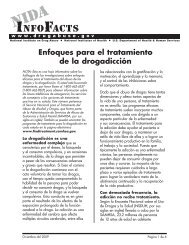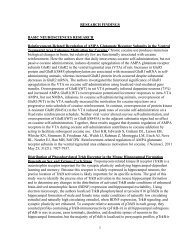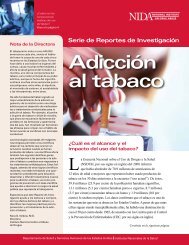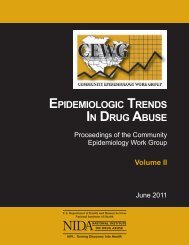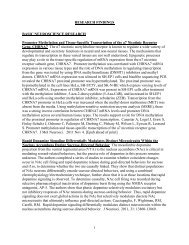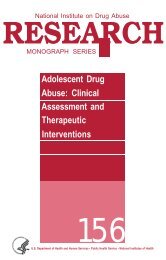CEWG January 09 Full Report - National Institute on Drug Abuse
CEWG January 09 Full Report - National Institute on Drug Abuse
CEWG January 09 Full Report - National Institute on Drug Abuse
Create successful ePaper yourself
Turn your PDF publications into a flip-book with our unique Google optimized e-Paper software.
Secti<strong>on</strong> III. <str<strong>on</strong>g>CEWG</str<strong>on</strong>g> Area Update Briefs and Internati<strong>on</strong>al Presentati<strong>on</strong>s<br />
NFLIS data (35 percent), and first in the APPD<br />
(45.8 percent). (It is not tested for in decedents.)<br />
Marijuana use was comm<strong>on</strong> by itself or in combinati<strong>on</strong><br />
with cocaine, alcohol, and phencyclidine<br />
(PCP), am<strong>on</strong>g others. Treatment admissi<strong>on</strong><br />
trends have been stable since 2001 with respect<br />
to gender (ranging from 78 to 82 percent male).<br />
The percentage of African Americans entering<br />
treatment increased from 68 to 75 percent from<br />
2006 to mid-2008, while proporti<strong>on</strong>s of Asians/<br />
others declined to very low levels. The proporti<strong>on</strong>s<br />
by age group for treatment admissi<strong>on</strong>s have<br />
remained stable from early 2005 through mid<br />
2008: with clients under age 21 c<strong>on</strong>stituting from<br />
9 to 9.4 percent; age 21–30, from 44 to 46.2 percent;<br />
age 31–40, from 27 to 26.7 percent; and age<br />
41 and over, from 19 to 17.7 percent. Alcohol in<br />
combinati<strong>on</strong> with other drugs declined from sec<strong>on</strong>d<br />
rank to third in deaths with drugs detected<br />
(present in 21.6 percent of decedents in the first<br />
half of 2008). It was most comm<strong>on</strong>ly reported as<br />
used al<strong>on</strong>g with or after cocaine, heroin, and/or<br />
marijuana. Alcohol was also the sec<strong>on</strong>d most frequently<br />
menti<strong>on</strong>ed drug in treatment admissi<strong>on</strong>s<br />
data (remaining stable at 22.1 percent) and seventh<br />
in the APPD study (5.4 percent). The proporti<strong>on</strong><br />
of African Americans entering treatment has<br />
changed from 49 percent in 2002 to 70 percent in<br />
the first half of 2008. C<strong>on</strong>comitantly, percentages<br />
of Whites have decreased from 41 to 26 percent<br />
during this period. Deaths with the presence of<br />
alcohol in combinati<strong>on</strong> decreased from a high of<br />
386 in 2006, to 264 in 2007, to 107 in the first half<br />
of 2008. The street-level purity of heroin declined<br />
from 2000 (73 percent) to 2004 (52 percent) and<br />
increased to 56.3 percent in 2007. The price per<br />
milligram pure has been fluctuating from $0.71<br />
in 2004, to $0.58 in 2005, $0.63 in 2006, and<br />
$0.71 in 2007; however, the standard bag price<br />
remained $10 and c<strong>on</strong>tained <strong>on</strong>e “hit.” In the first<br />
half of 2008, heroin ranked fourth in treatment<br />
admissi<strong>on</strong>s (17.9 percent), moving from third<br />
to sec<strong>on</strong>d in deaths with the presence of drugs<br />
(25.8 percent); it was third in the NFLIS data,<br />
and fifth in the APPD data (within the category<br />
“total opioids,” at 13.2 percent). At the beginning<br />
of the period of declining heroin purity in 2001,<br />
Whites comprised 54 percent of treatment admissi<strong>on</strong>s<br />
and had increased to over 68 percent by<br />
mid-2008. Proporti<strong>on</strong>s of African Americans<br />
declined from 42 percent in 2001 to 23 percent by<br />
mid-2008. As the purity levels bottomed out, the<br />
21–30 age group entered treatment in increasing<br />
proporti<strong>on</strong>s (from 22 percent in 2001 to 42 percent<br />
in 2005), and as the purity leveled off in 2006,<br />
so did this populati<strong>on</strong> entering treatment. Deaths<br />
with the presence of heroin closely matched the<br />
purity trends from 2001 through mid-2008, with<br />
the excepti<strong>on</strong> of the period of the fentanyl outbreak<br />
from spring 2006 to spring 2007. Heroin<br />
was most comm<strong>on</strong>ly reported as used in combinati<strong>on</strong><br />
with cocaine, alprazolam, alcohol, and/or<br />
oxycod<strong>on</strong>e. In the first half of 2008, 88 percent of<br />
females and 85 percent of males reported injecti<strong>on</strong><br />
as their preferred route of administrati<strong>on</strong>. Within<br />
the other opioids category, use was characterized<br />
as at medium levels with mixed indicator results,<br />
depending <strong>on</strong> the drug. Codeine and oxycod<strong>on</strong>e<br />
remained low in treatment admissi<strong>on</strong>s, but relatively<br />
high in the Philadelphia Medical Examiner’s<br />
(ME’s) toxicology reports. However, six “other<br />
opioids” were in the top 15 drugs in the NFLIS<br />
report for the first half of 2008—oxycod<strong>on</strong>e (4th),<br />
codeine (7th), hydrocod<strong>on</strong>e (8th), methad<strong>on</strong>e<br />
(10th), buprenorphine (14th), and propoxyphene<br />
(15th). Benzodiazepine use, while lower than<br />
use of drugs discussed above, remained a drug<br />
used in combinati<strong>on</strong> with other drugs according<br />
to trend data. Indicati<strong>on</strong>s of abuse appeared to<br />
be increasing in the first half of 2008. Benzodiazepines<br />
ranked third in the mortality data. Alprazolam<br />
is clearly the benzodiazepine of choice,<br />
ranking seventh in the ME’s toxicology reports<br />
and fifth in the NFLIS data. Alprazolam is most<br />
comm<strong>on</strong>ly used in combinati<strong>on</strong> with heroin and/<br />
or oxycod<strong>on</strong>e. PCP is primarily smoked in combinati<strong>on</strong><br />
with marijuana in blunts. Indicators reflect<br />
medium levels of use, and indicators were either<br />
stable or declined in the first half of 2008, with<br />
the excepti<strong>on</strong> of the APPD study, where 12 percent<br />
of the (positive) tests were positive for PCP<br />
in the full calendar year 2008. The most comm<strong>on</strong><br />
Proceedings of the Community Epidemiology Work Group, <str<strong>on</strong>g>January</str<strong>on</strong>g> 20<str<strong>on</strong>g>09</str<strong>on</strong>g> 59



